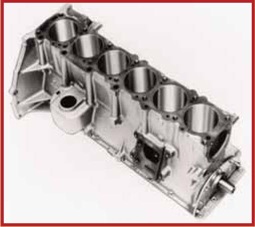

By: Jim Black • Papillion, NebraskaLong before the series II 3800 V-6, or the technologically advanced Vortec 4200 inline six offered by GM, Pontiac had its own exclusive ohc6 that was for a time, the most sophisticated engine ever produced by General Motors. The brainchild of John DeLorean, then Pontiac’s Chief Engineer; this SOHC six-cylinder engine was developed to power Pontiac’s increasingly larger Tempest and LeMans intermediates, but DeLorean took a different approach to the design that would include a “first for the U.S. market”, belt-driven overhead camshaft.
The idea of an overhead cam engine was not new. Gear-driven overhead cam engines were predominant on the world racing scene, but were complicated, expensive, and difficult to maintain in their racing form. However, the European’s had been building chain-driven, toned down versions for years and with good success on their regular production models. The concept of a belt-driven cam however, was untested territory for a regular production automobile.
The ohc6 was based off of Chevrolet’s 230 cubic inch L-head six-cylinder engine but nearly all components were either modified or of a completely new design. The ohc6 had a bore of 3.875 inches and a stroke of 3.250 inches with a 9.0:1 compression ratio. The crankshaft was a cast nodular-iron design supported by seven main bearings and the block was extended well below the crankshaft centerline to provide greater stiffness, improve bearing life, and minimize vibration. The steel forged connecting rods were conventional in design and attached to cast aluminum flat-headed pistons of a slipper skirt design that contained deep recesses for the valve heads. The pistons did not include any expansion control devices which differed from those found in other engines.
The camshaft was mounted directly within a cast aluminum cam cover housing which rode on seven bearings that were actually part of the cam cover itself. The camshaft was made of hardened iron and had wider bearing journals and lobes that were of a larger diameter and width, unlike those used in a normal pushrod engine. The camshaft had .400 inches of lift and 228 degrees of duration and was mounted directly atop the valves. This lack of valve-train design and greatly increased stiffness reduced the mass inertia by 27% yielding much greater rpm and horsepower with virtually no valve float occurring at higher rpms.
The overhead camshaft was driven by a fiberglass-reinforced “Gilmer” belt that was cogged and similar in design to the belts that drive superchargers. This was a major design deviation from previous overhead cam engines that drove the cams via gear sets and/ or chains. The 1-inch wide belt rode on large diameter cast-iron sprockets to help reduce bending fatigue on the belt and improve its life span. The major concern of the engineers was whether the belt would hold up to the day-to-day requirements of normal driving and provide an adequate service life. Early testing followed by a long service life validated the design and few if any belt failures were reported.
An early 215ci flathead six with the all-new 230ci Single-OHC six.

The Pontiac OHC6 engine was based off
Chevy’s 230ci L-head 6 cylinder bottom end
.
Another unique feature of this all-new design was the cast aluminum accessory drive housing which was located externally on the right side of the engine. The accessory drive housing was held in place by six bolts on adjustable slotted mounts which acted as the adjustment for tensioning of the overhead cam belt. The accessory housing also had attachments to support the distributor, fuel pump, oil pump and oil filter, and since these accessories along with the overhead camshaft were all driven by the same belt, this simplified the design, manufacture, and servicing of the engine.
The overhead cam six engine was fed via a single-barrel Rochester carburetor and both intake and exhaust manifolds were made of cast iron and attached to one another. The 230 ci engine developed 165 bhp at 4700 rpm and 216 lb-ft of torque at 2600 rpm, twenty-five more horsepower than the Chevy engine it was based upon which was a major innovation. Immediately after the design and testing of the ohc6 engine began, DeLorean ordered that a high performance version also be developed.
The high performance version or “sprint option” as it was called, utilized the same bore and stroke but many changes were made to achieve greater horsepower and torque. As with any performance upgrade an increase in intake volume and exhaust will always improve performance. The engineering team used this approach by installing an all new 4-barrel Rochester “Quadra-Jet” carburetor, the same used on Chevrolet’s 396 ci V-8, that featured a small primary venturi and larger secondaries. The carburetor was bolted to a redesigned cast iron intake manifold with “tuned” individual runners for each intake port. A specially designed “split” exhaust manifold was also used to increase exhaust gas output by eliminating exhaust gas interference between cylinders.
In this side view of a 1966 “Sprint” OHC6, you can clearly see the combination intake and exhaust setup that featured a specially designed “split” manifold to increase exhaust output.
Cut-away view shows the tall design of this OHC-6 engine and the proximity of the valves to the overhead camshaft. The camshaft was mounted within the cam cover and placed directly atop the valves.
The increase in flow was teamed with a different camshaft with .438 inches of lift and 244 degrees of duration. The same valves were used but valve spring pressure was increased by doubling up on springs (one inner and one outer) for each valve, and a higher 10.5:1 compression ratio. Using premium fuel which was recommended, the “sprint” produced 207 bhp at 5200 rpm and 228 lb-ft of torque at 3800 rpm. This “spirited” six-cylinder was also capable of revs to 6500 rpm and beyond.
During its four year run (1966–‘69) the ohc6 continued with minor improvements in horsepower. In 1967 the “sprint” version saw an increase from 207 to 215 bhp. In 1968 the ohc6 was stroked to 250 ci with an increase to 175 bhp for the base ohc6 and no gains for the “sprint” that year. In 1969 horsepower remained at 175/215 but a new “high output” version was offered for manual transmission cars which yielded 230 bhp at 5400 rpm and 260 lb-ft of torque at 3600 rpm. The increase was due to a redesigned “H” camshaft that had yet more duration.
The all-new ohc6 engine actually saw its first use in the 1964 XP-833 “Banshee” show car. The “Banshee” was a dedicated two-seat sports car much like the Chevrolet Corvette that DeLorean was attempting to bring into production, but the idea was later killed by corporate executives. Apparently the GM brass didn’t want other in-house competition for the Corvette in the two-seat category. Following the ohc6’s lengthy testing phase, it was soon offered as the base power-plant in the 1966 models as a way to inject some sophistication and a European feel into the intermediate lineup. The ohc6 engine was only offered from 1966 through 1969 model years as the standard engine for the Pontiac Tempest and LeMans as well as the Firebird from 1967–69. The “sprint option” was also offered on these models but was usually incorporated as a package with a standard 3-speed floor shift and heavy duty suspension. No other models ever offered the ohc6 as an engine option.
The cast aluminum accessory drive housing is located on the right side of the engine which supports the distributor, fuel pump, and oil filter. In this photo you can also see the engine block casting number located just right of the oil fill tube. The engine serial number was located on the stamping pad immediately above the oil filter, right of the fuel pump.
The “Sprint” optioned Tempest, LeMans, and Firebird were lighter, well balanced, and handled better than the heavier V-8 equipped models. The high-revving “Sprints” also had performance that equaled or bested entry level V-8’s of the period. In a Motor Trend Magazine performance test a Royal Bobcat prepared ‘66 Tempest “Sprint” with 4-speed, ran a high 14-second quarter mile at 91 mph which was better than the 16-second and 80 mph performance recorded by other automotive magazines.
The overhead cam six though innovative had some problems worth noting. In checking 1966–67 factory service bulletins it’s clear that failed camshafts occurred from lobe scuffing due to oil starvation and/or poor assembly techniques. Other problems encountered included stuck lash adjusters that occurred more frequently. It should also be noted that since the engine was non-conventional in design, finding mechanics experienced and knowledgeable was at best difficult and this is especially true today.
Pontiac’s four-year run of the ohc6 ended due to a couple of contributing factors including both cost and timing. The cost of production was high even with many innovations taken to reduce the costs (an entry level 326 ci V-8 actually cost less than the “sprint optioned” versions). As for timing, anyone who grew up in the ‘60’s knew that the V-8 was king and with cheap gas available, only a small number of ohc6’s were produced. In retrospect, had the ohc6 remained in production thru the oil embargo of 1973, we might well have seen this engine remain in production. Today’s six-cylinder SOHC and DOHC engines owe there linages to the early advances made by this revolutionary engine.
Currently, auto hobby organizations are attempting to promote the preservation, enjoyment, and restoration of these historically powered vehicles. An official ohc6 Registry has also been established in an effort to document those that remain. If you would like to learn more about Pontiac’s ohc6 please contact the author at: 307 Summerset Dr.; Papillion, NE 68133 or at E-mail: gtojr@cox.net.
OHC6 Performance Figures
1966 LeMans “Sprint” 230 ci / 207 hp: 1966 Tempest ‘Sprint’ 230 ci / 207 hp*: 1/4 mile 16.7 @ 80 mph Car & Driver 1/4 mile 14.9 @ 91 mph Motor Trend
1/4 mile 16.7@ 83 mph Car Life * Royal Bobcat prepared NOTE: All cars tested were four speed manuals 1/4 mile 16.0 @ 86 mph HP Cars